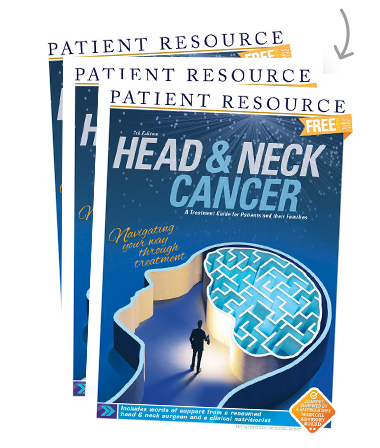Head & Neck Cancer
Side Effects
Most cancer treatments have side effects, but some can be managed or minimized, and others can even be prevented. The key is you. Be an active participant in your care by talking with your health care team about those to watch for and what to do if they occur. Then, let your team know as soon as a side effect begins. The sooner you reach out, the sooner you may get relief.
People primarily think of physical side effects with cancer treatment, but you and your loved ones may also experience emotional, practical, nutritional, spiritual, financial and other challenges associated with cancer. Your health care team is standing by to address these with supportive care services.
Supportive care is sometimes called palliative care, which is often confused with hospice care. They are not the same thing. Hospice is reserved for end-of-life care, and supportive care is available immediately after the diagnosis of any serious illness.
Potentially Severe Side Effects
Though serious side effects are rare, they can occur with certain treatments. Ask your doctor whether the therapies in your treatment plan put you at risk and, if so, how to identify the symptoms and when to report symptoms and seek emergency care.
- Infection can occur as a result of a low white blood cell count (neutropenia) and other factors.
- Immune-related adverse events (irAEs) may occur if the immune system becomes overstimulated by treatment and causes inflammation in one or more organs or systems in the body. Some irAEs can develop rapidly, becoming severe and even life-threatening without immediate medical attention.
- Cytokine release syndrome can occur if immune cells affected by treatment rapidly release large amounts of cytokines into the bloodstream. Symptoms may include headache, fever, nausea, rash, low blood pressure, rapid heartbeat and difficulty breathing.
- Infusion-related reactions most frequently occur with intravenous (IV) treatments, usually soon after exposure to the drug.
- Tumor lysis syndrome (TLS) may occur after the treatment of a fast-growing cancer and with some types of drug therapy. TLS can potentially damage the kidneys, heart, liver and other organs.
Common Side Effects
Some common side effects of head and neck cancer treatments are listed in Table 1. Having multiple treatments can intensify side effects, but keep in mind that every person responds to treatment differently. Also, be aware of side effects that develop weeks, months or years after treatment ends. These are called late effects. Some disappear over time, while others are permanent.
Acknowledge Emotional Side Effects
A cancer diagnosis affects more than your body. It also affects your well-being, self-confidence and overall mental health, making it important to take advantage of the supportive care services available. Support is accessible in many forms, both in person and online. Some organizations offer one-on-one buddy programs that pair you with another person who has the same type of cancer as you. Sharing your feelings with people who have been through something similar can be very helpful.
Advocacy groups and national organizations are also available (see Resources). Some organizations specifically help head and neck cancer survivors manage the unique financial challenges of treatment. Through donations, grants and volunteers, patients are able to move forward with treatment and recovery with much-needed help in a variety of areas, from access to liquid nutrition and transportation to medical appointments and custom dental prosthetics.
Some Common Side Effects of Head and Neck Cancer Treatment
| Side Effect* | Symptoms |
| Anemia | Low energy, weakness, dizziness, light-headedness, shortness of breath, rapid heartbeat |
| Bone loss and pain | Weakened bone caused by the cancer or treatment |
| Chemo brain (cognitive dysfunction) | Brain fog, confusion and/or memory problems |
| Constipation | Difficulty passing stools or less frequent bowel movements compared to your usual bowel habits |
| Decreased appetite | Eating less than usual, feeling full after minimal eating, not feeling hungry |
| Diarrhea | Frequent loose or watery bowel movements that are commonly an inconvenience but can become serious if left untreated |
| Difficulty swallowing | Also called dysphagia; may include painful swallowing. |
| Fatigue | Tiredness that is much stronger and harder to relieve than the fatigue an otherwise healthy person has |
| Fever | Raised body temperature that could signal an infection |
| Hair loss (alopecia) | Hair loss on the head, face and body |
| Headache | Pain or discomfort in the head |
| Lymphedema | Swelling where lymph nodes have been removed or damaged |
| Nausea and vomiting | The feeling of needing to throw up and/or throwing up |
| Neuropathy | Numbness, pain, burning sensations and tingling, usually in the hands or feet at first |
| Neutropenia | Low white blood cell count that increases the risk of infection |
| Pain | Pain and aches that occur in the muscles, bones, tendons, ligaments or nerves |
| Respiratory problems | Shortness of breath (dyspnea) with or without cough, upper respiratory infections. |
| Skin reactions | Rash, redness and irritation or dry, flaky or peeling skin that may itch |
| Thrombocytopenia | Low number of platelets in the blood, which can lead to bruising and bleeding |
| Trismus | Jaw stiffness, reduced ability to open mouth wide, pain opening and closing mouth |
| Weight changes | Gaining or losing weight unintentionally |
*Side effects listed alphabetically. Talk to your health care provider about what to expect with your treatment.



